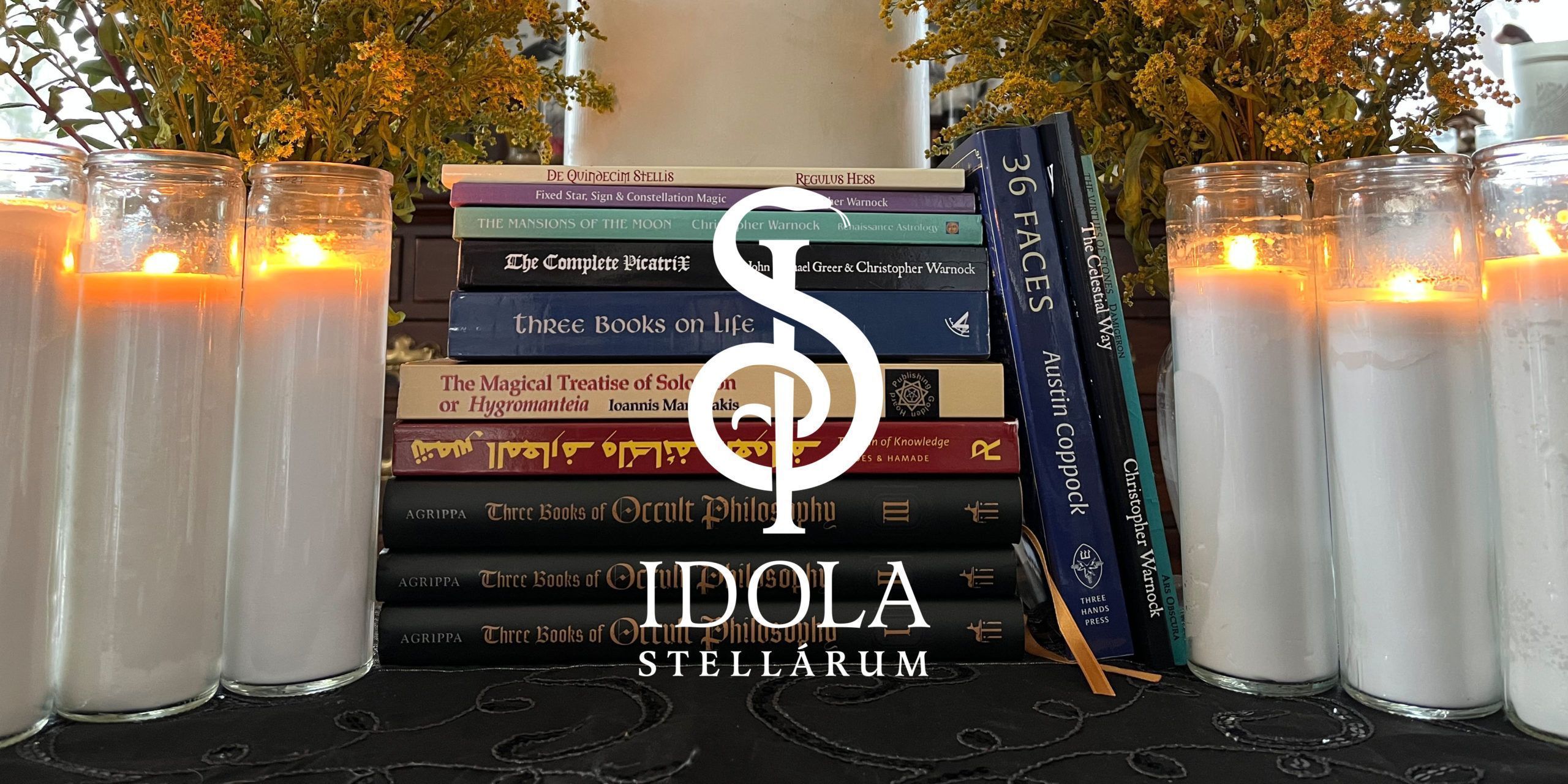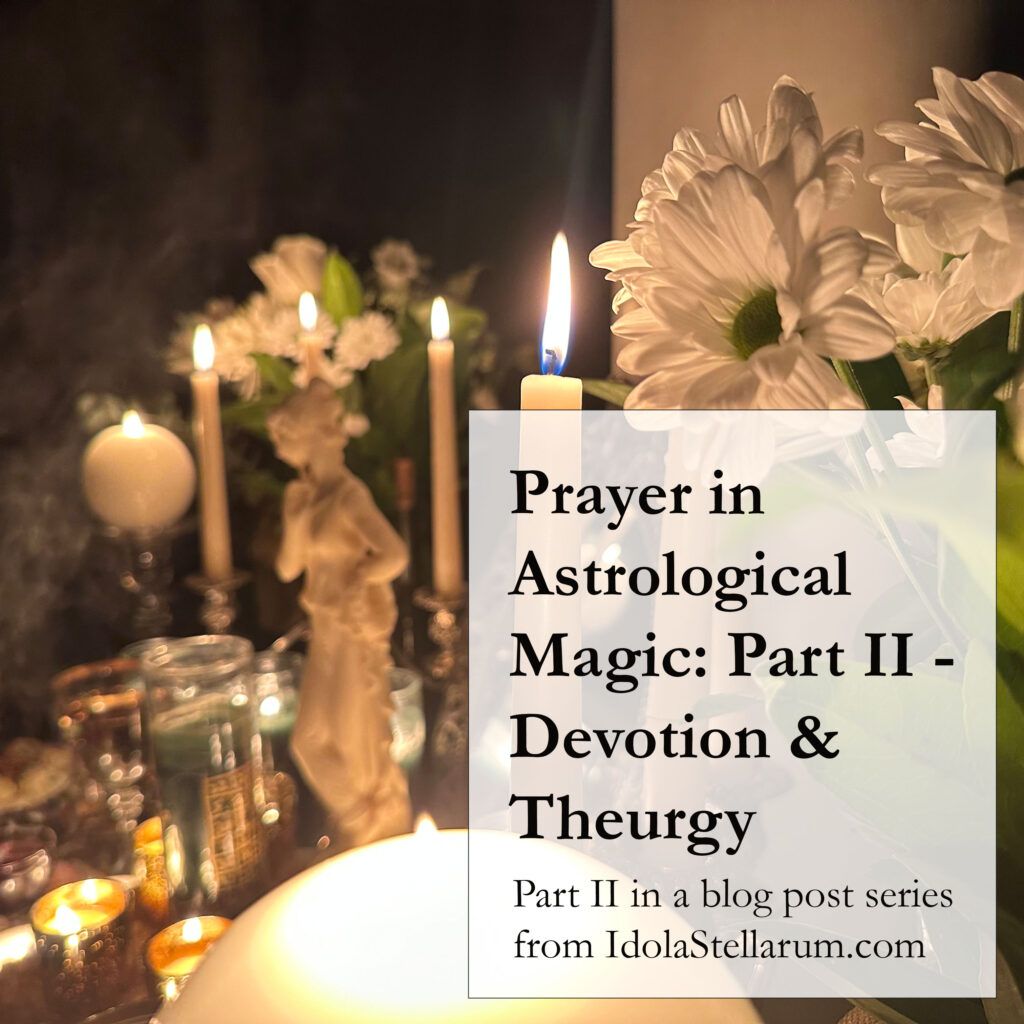Your cart is currently empty!

Prayer in Astrological Magic: Part II – Theurgy & Devotion
In Part I of this post series, we examined our current most central sources in the tradition to establish that there is a nearly univocal claim that words—inscriptions, invocations, prayers—play an important role in astrological magic. In this post, we turn again to our source texts to establish the role and function of prayer in astrological magic.
To get at the purpose of prayer in astrological magic we need to take a step back and consider the function of prayer more generally: typically, it is to connect with, supplicate, or invoke the divine. It would be useful to know whether this is necessary in astrological magic, and if so, why.
Below, we make a case based in our reading of the traditional texts that astrological magic is or ought to be theurgic at its core. That is, making astrological talismans is a fundamentally devotional enterprise that calls upon the astromage to participate with and in the divine. Astromagic is god-work.
You “Gotta Have Faith, Faith, Faith”
Although he is not provably within the lineage of astrological talismanic magic, a core tenet of talismanic operations was admirably summed up by the musician George Michael: you “gotta have faith, faith faith.” Many historical sources emphasize the importance of faith and belief in astromagical operations. For example, the Picatrix states:
“[Astrological magicians] ought to believe firmly in the works that they do with images, so that what they do will be true and without doubt, nor should they harbor doubts concerning its effectiveness, since this work is not done in order to test or prove whether it be true or not; rather, they should have faith in their mind that it be true.”
—Picatrix, Book I, Chapter 4, tr. John Michael Greer & Christopher Warnock
Similarly, Agrippa, in a series of chapters, carefully lays out an account of how the human mind, through thoughts, passions, intentions, and eventually spoken words, have an effect beyond the mind of the person—on the world and on other people, but also on and with the celestial spirits. A full accounting of Agrippa’s view would make an interesting longform article in its own right, but for now it suffices to quote a single passage explicitly on the question of faith:
“Indeed, our mind works much through faith, which is a firm link, a fixed intention, and vehement application of the operation or undertaking in whatever thing cooperating with and giving power to the work that we intend to accomplish, so that an image of the virtue being received is made in us in a certain way and creates things in us or from us. Therefore, we must vehemently aspire, imagine, expect, and firmly believe in any operation and thing applied. Indeed, it will be the greatest help.”
—Agrippa, Three Books of Occult Philosophy, Book I, Chapter 66, tr. Eric Purdue
Faith will, as Agrippa says, “be the greatest help.” But why should this be so? Other occultists who were invested in image magic, such as Albertus Magnus, construed talismans as operating via natural rather than supernatural principles. At least in a modern scientific understanding of ‘natural,’ we would expect something natural to operate regardless of someone’s attitude toward it or belief in it.
“Love and Faith Toward a Celestial Gift”
To understand why historical sources emphasize the role of faith and belief, we need to examine their understanding of how talismanic operations worked. The quotation above from Picatrix stating that the mage should have faith in their mind that the working be true continues as follows:
“By [the mage’s faith] the rational spirit is strengthened, and joined to that virtue of the upper world from which proceeds the celestial spirit that acts in the image; and in this way, what is desired will come to pass. Thus it is is necessary to believe firmly, because it is by this that the image will have the power to call upon the cooperation of the intelligence”
—Picatrix, Book I, Chapter 4, tr. John Michael Greer & Christopher Warnock
Take note that Picatrix does not state that faith would be a nice thing to have, or would make the mage feel good, or would merely enhance or augment the working. The text seems to be saying that the mage’s faith actually serves as an essential condition for the talismanic image to connect up with the relevant celestial intelligence: it is necessary to believe firmly, because it is by this that the operation will be effective.
Marsilio Ficino makes a similar point (perhaps because he was likely drawing upon or even summarizing the Picatrix) from a slightly different angle that will help us think through the role of faith:
“[W]hen we fashion images rightly, our spirit, if it has been intent upon the work of the stars through imagination and emotion, is joined together with the very spirit of the world and with the rays of the stars through which the world-spirit acts. And when our spirit has been so joined, it too becomes a cause why (from the world-spirit by way of the rays) a particular spirit of any given star, that is, a certain vital power, is poured into the image–especially a power which is consistent with the spirit of the operator.”
—Marsilio Ficino, Three Books on Life, Book III, Chapter XX, tr. Carol V. Kaske & John R. Clark
Elsewhere in Chapter XX he notes that “love and faith toward a celestial gift are often the cause of celestial aid.” The language of ‘cause’ is interesting, not because it implicates a mechanical model, but because it suggests that the mage plays a crucial operational role in magical workings, without which the intended effect may not come to pass.
Both Picatrix and Ficino describe a model in which the mage serves as a crucial intermediary that plays a central role in linking the sublunary realm (i.e., the talismanic image) to the celestial realm (i.e., the celestial intelligence being invoked). This link, they emphasize, only works when the mage is in the proper state—one of belief, faith, imagination, and passion. Without this “love and faith toward [the] celestial gift,” it is like a circuit that does not fully close, or like a relationship with no chemistry: lacking a crucial, vital spark, the talisman may in all likelihood end up inert rather than magically ensouled.
The Theurgic Nature of Talismanic Magic
It may be useful to view talismanic operations through the distinction of theurgy and thaumaturgy. Erik Arneson defines theurgy as “god working” aimed at “rais[ing] the consciousness, soul, or intellect of the practitioner to reach higher realms,” and defines thaumaturgy as “wonder working” aimed at “caus[ing] change in the material world [rather than on] raising the consciousness of the practitioner.”
Astrological magic in this tradition seems to sit at an interesting halfway point between these two concepts. Although astrological magic ultimately aims at practical and even wondrous effects, these effects are not seen as originating from the mage or even immediately from the talismanic working, but by a celestial power invoked during the working who will operate according to their own agency and timeline.
The quotations above from Picatrix, Ficino, and Agrippa suggest that the talismanic operation itself has a theurgic slant. In the talismanic ritual, the mage adopts or instills in themselves a theurgic state—of intention, belief, faith, and enlivened passion and bolstered spirit—to invoke a celestial intelligence and enable the spiritual-magical fulfillment of the talismanic image.
The following passage from Agrippa directly makes the link between the state of consciousness of the mage and the workings of the powers of the celestials:
“Therefore, it is greatly conducive in any work for receiving the benefit of the heavens, if, in our thoughts, dispositions, imaginations, elections, deliberations, contemplations, and the like, we excel in being harmonious with the heavens. Indeed, passions of this sort vehemently excite our spirit toward their like and suddenly expose us to our superiors, which signify those kinds of passions. Then, because of their dignity and closeness with the superiors, our thoughts capture the power of the celestials much more, and do so to a much greater extent than any material thing can.”
—Agrippa, Three Books of Occult Philosophy, Book I, Chapter 66, tr. Eric Purdue
Given all of this, we might say that astrological magic is theurgy in the service of thaumaturgy: through god-working, wonders come to pass. The astromage, through their enlivened and inspirited faith and passion during a talismanic operation, occasions the unfolding of celestial gifts, which come to pass through the talismanic spirit, whose ensoulment into the talisman was enabled through the mage’s theurgic consciousness.
Devotional Prayer in Astrological Magic
What we are establishing here is that astrological magic is not a neutral, dispassionate, mechanical act, but one in which the mage, as Ficino puts it, joins their spirit with the celestials. In talismanic ritual, the mage’s ability to make “the power of [their] spirit united with the power of the heavens” (Picatrix, Book I, Chapter 5) is essential to the operation’s success. The theurgical philosopher Iamblichus writes:
“According to the Ancients, the souls freed from generation coadminister the cosmos with the Gods, but according to the Platonists they contemplate their divine hierarchy. And in the same way, according to the Ancients, liberated souls create the cosmos together with the angels, but according to the Platonists they accompany them in the circular journey.”
—Iamblichus, Stobaeus I, 458, 17-21
But how does the mage do this? Perhaps some experienced mages can drop into a state of gnosis at will, but in general, this sort of state is achieved through the mage becoming inflamed by prayer: Iamblichus notes that “At the moment of prayer, the divine itself is literally joined with itself, and it is united with the spiritual conceptions in prayer but not as one thing is joined to another” (De Mysteriis, 47, 9-11).
Through prayer, the mage joins the celestial powers in the divine act of creation. To riff on Crowley, the astrological magician uses the methods of theurgy with the aims of thaumaturgy.
In the next post in this series, we will explore in more depth the functions of prayer in the talismanic ritual. In closing, we quote a summary made in the Picatrix of rituals for making astrological talismans:
“[The ancient Greek sages] placed [a planet] in the degree of the midheaven, and burned an incense appropriate to the planet, and made sacrifices with prayers likewise corresponding to the planet, and asked that whatever they willed, they would obtain. They said also to work similarly with a planet when it was rising, and similarly accomplished what they willed”
—Picatrix, Book I, Chapter 5, emphasis added
If prayer were entirely optional or an afterthought, it is hard to imagine why it would be featured in such a condensed description of the process. In our view, prayer, devotion, and theurgical elevation are central not to the theater of astrological magic, but to its mechanism.
As stewards of the tradition of astrological magic, it is our privilege to bring the wonder of astrological talismans to others. Sign up to our mailing list for word of our upcoming talismanic collections and workings:
By clicking ‘subscribe’, I consent to Idola Stellarum storing my email and information solely for the purpose of communicating upcoming offerings and content, and I am able to unsubscribe at anytime.

